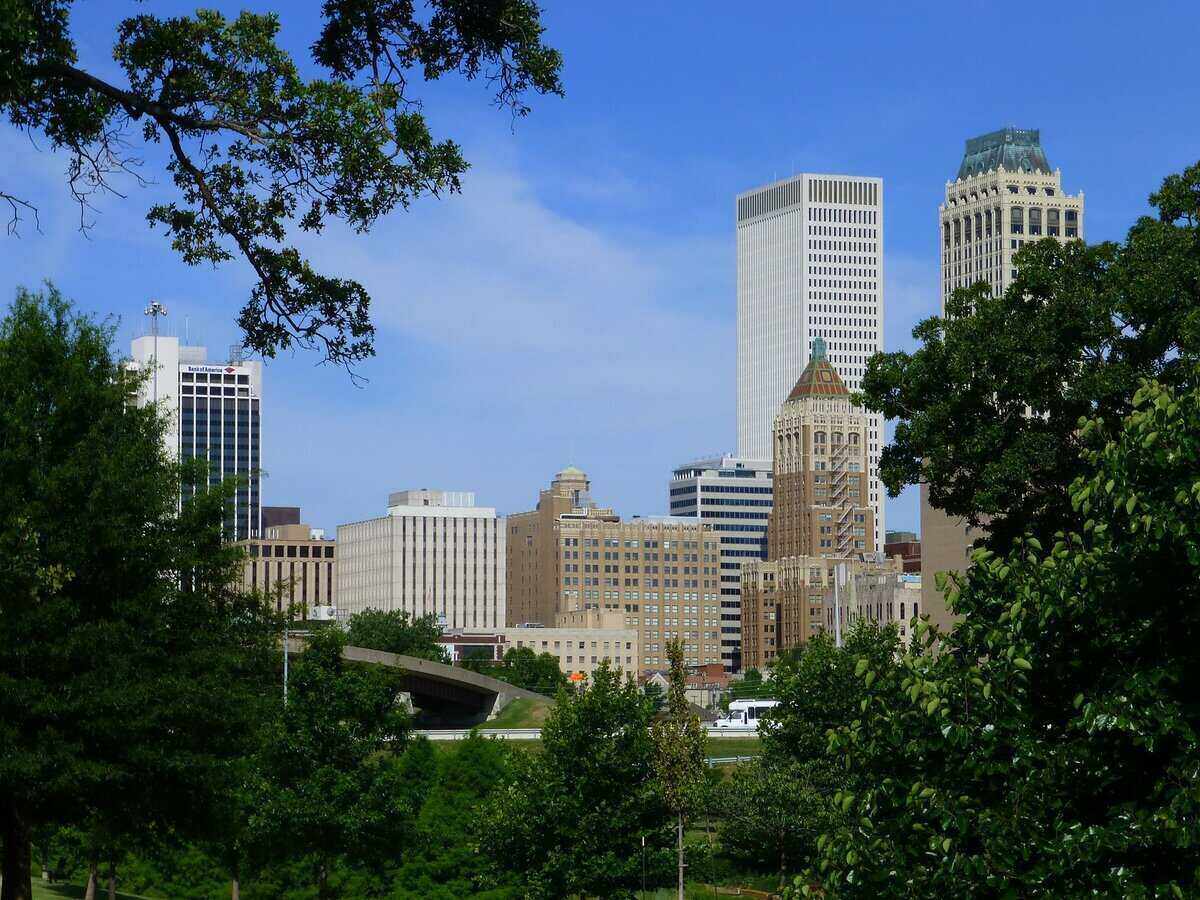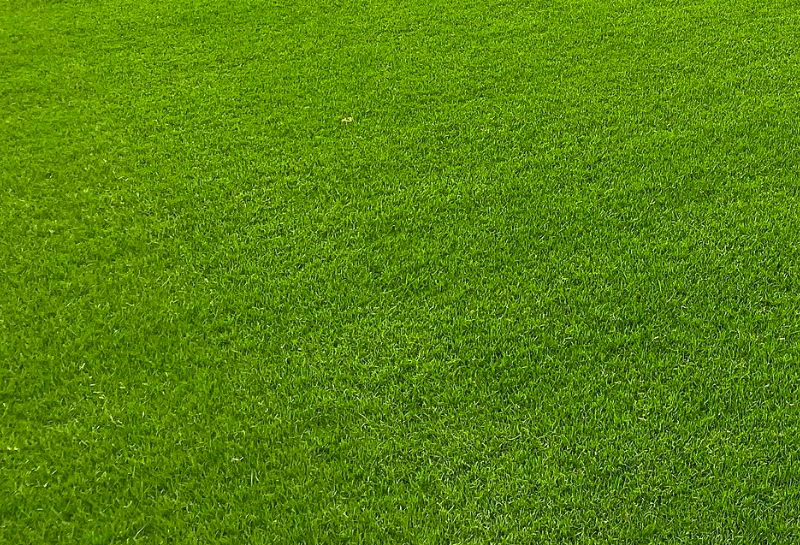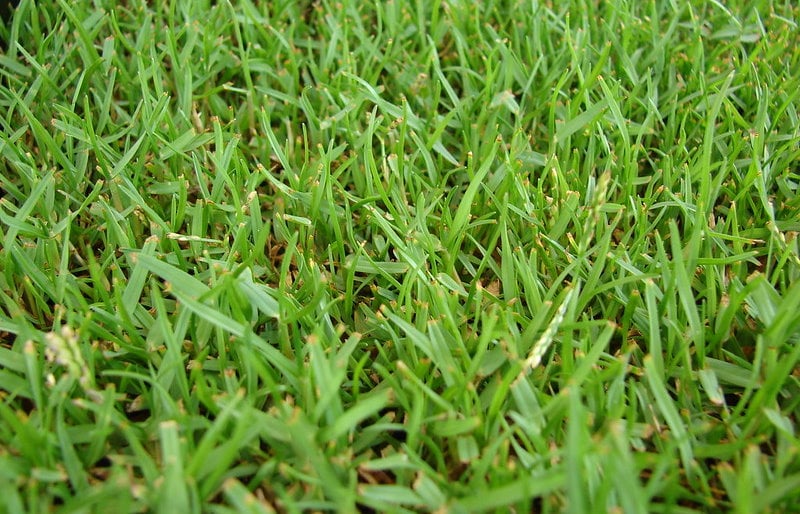
Since Oklahomans plant both cool- and warm-season grasses, you may wonder which type of grass is best for your Tulsa lawn.
There are four types that thrive in Tulsa:
These cool- and warm-season grasses make the best of a challenging climate. Discover which grass type will grow best on your property.
1. Bermudagrass

Gilba Solutions Pty Ltd | Wikimedia Commons | CC BY-SA 4.0
Bermudagrass is the most popular grass in Oklahoma home lawns. It withstands foot traffic well, is drought-resistant, and is relatively cold-tolerant. Got shade? This is not the grass for you. Bermudagrass must have full sun.
Bermudagrass establishes relatively quickly and can be used in a variety of settings, including athletic fields, golf courses, and home lawns. The common varieties, which are recommended for home lawns, have a medium texture, whereas the hybrid varieties that are used for athletic fields have a fine texture. This grass needs to be dethatched regularly.
- Classification: Warm-season grass
- Spreads by: Stolons and rhizomes
- Shade tolerance: Low
- Drought tolerance: High
- Foot traffic tolerance: High
- Maintenance needs: Moderate if you plant a medium-textured common variety. Fine-textured hybrid cultivars require more maintenance and are usually found on athletic fields. Common bermudagrass lawns prefer at least three applications of fertilizer in May, June, and August. Use a slow-release fertilizer for the June and August applications.
- Mowing height: 1-3 inches
- Potential for disease: Moderate; prone to spring dead spot
Other notes: Choose a cultivar that has adequate cold tolerance for your area and consider a blend of three or more varieties if you plan to establish from seed. Arizona common, Guymon, and U-3 are cultivars that can be propagated from seed or vegetatively (sod, sprigs, plugs). Other cultivars are only available as sod, sprigs, or plugs (not from seed). Some cultivars are somewhat or highly resistant to spring dead spot, so consider this when choosing which variety(ies) to plant.
Grass Seed Options:
– Pennington Bermudagrass Bare Spot (5 lb. bag)
– Pennington Smart Seed Bermudagrass Mix (8.75-lb. bag)
– Scotts Turf Builder Bermudagrass (10-lb. bag)
– Hancock Seed Co. Bermudagrass (50-lb. bag)
2. Kentucky bluegrass

Brenda Ryan | Lawn Love
Kentucky bluegrass produces beautiful green grass under ideal conditions, but Oklahoma weather can be challenging for this species of turf. It is recommended to use a mix of Kentucky bluegrass and tall fescue for the best results.
Most grasses prefer full sun, but in Oklahoma, the cool-season grasses like Kentucky bluegrass prefer partial shade. No grass will do well in heavy shade. If you have heavy shade, consider other grass alternatives. If you have light shade, consider Kentucky bluegrass or tall fescue.
- Classification: Cool-season grass
- Spreads by: Rhizomes
- Shade tolerance: Good
- Drought tolerance: Moderate to high; will likely go dormant without supplemental water, especially if planted in full sun. If it does go dormant, its rhizomes help it to recover quickly once regular watering resumes.
- Foot traffic tolerance: Moderate; higher tolerance in full sun than in the shade
- Maintenance needs: Moderate to high; likes supplemental irrigation and at least two applications of fertilizer per year
- Mowing height: 2.5 inches
- Potential for disease: Moderate to high; susceptible to summer patch disease
Other notes: Develops a moderate level of thatch over time. Plan to dethatch every few years. Kentucky bluegrass is best adapted (chart on pg. 2) for the northern part of Oklahoma.
Grass Seed Options:
– Jonathan Green (11970) Blue Panther Kentucky Bluegrass Grass Seed (3 lbs.)
– SeedRanch Midnight Kentucky Bluegrass Seed (5 lbs.)
– Jacklin Seed – Biltmore Blue Blend – 100% Kentucky Bluegrass (5 lbs.)
3. Tall fescue

Ty Haller | Flickr | CC BY-SA 2.0
Tall fescue is another cool-season grass that can be useful in lawns with partial shade. Cool-season grasses thrive in the fall and spring and may go dormant during the summer unless you provide supplemental watering, especially for areas with more sun.
Tall fescue does best when you buy it in a mix with Kentucky bluegrass. This helps your lawn to be more disease resistant and increases its genetic diversity.
- Classification: Cool-season grass
- Spreads by: Most varieties are bunching, but some have rhizomes
- Shade tolerance: Good
- Drought tolerance: Needs supplemental irrigation during the summer, especially if you plant in a sunny area
- Foot traffic tolerance: Lower in shaded areas, moderate in full sun
- Maintenance needs: Moderate to high. Prefers two applications of fertilizer each year, one in spring and one in fall.
- Mowing height: 2.5-3 inches
- Potential for disease: Moderate to high; susceptible to brown patch disease and Rhizoctonia blight
Other notes: Proper mowing, fertilization, watering, and sun/shade conditions can help lessen disease pressure
Grass Seed Options:
– Triple-Play Tall Fescue Grass Seed Blend (5000 sq ft)
– Eretz Kentucky 31 K31 Tall Fescue Grass Seed (choose your size)
– Pennington The Rebels Tall Fescue Grass Seed Mix (7 lb.)
4. Zoysiagrass

Forest and Kim Starr | Flickr | CC BY-SA 2.0
Like bermudagrass, Zoysiagrass loves the sun, but this grass can withstand “light shade” (pg. 4). It requires less fertilizer than bermudagrass but is prone to thatch. Zoysiagrass withstands moderate foot traffic but can be slow to recover from traffic stress.
If you are interested in establishing a Zoysiagrass lawn, experts recommend starting it from sod. Zoysiagrass is a slow grower, so establishing from sod gives you an instant lawn look and prevents weeds and other management problems that come from having to establish a slow-growing grass from seed.
Meyer Zoysiagrass is the most common cultivar in Oklahoma and works well in the eastern part of the state.
- Classification: Warm-season grass
- Spreads by: Stolons and rhizomes
- Shade tolerance: Fair
- Drought tolerance: Generally good, but depends on the cultivar
- Foot traffic tolerance: Good
- Maintenance needs: Moderate. Fertilize no more than three times per year (can fertilize less than this for a low or moderate level of maintenance). It doesn’t need as much fertilizer as bermuda.
- Mowing height: 1-1.5 inches
- Potential for disease: Moderate to high
Other notes: Prone to thatch buildup and large patch of Zoysiagrass (a lawn disease). The best way to prevent or reduce large patch of Zoysiagrass is to control thatch and ensure your soil drains well. In addition, if the grass is showing signs of drought stress, water between 5 a.m. and 9 a.m., and don’t mow infected areas when the grass is wet.
Grass Plug and Seed Options:
– Zoysia Plugs (50 Large Grass Plugs)
– Zoysia Plugs (50 Full & Lush Grass Plugs)
– Zoysia Plugs (100 Plugs)
– Zoysia Emerald Grass Seeds (1/8 lb. of seeds)
– Zenith Zenith Grass Seeds (1/8 lb. of seeds)
How to select the best grass type for your Tulsa lawn
Here are a few questions to ask yourself to determine which grass type is best for your lawn. If you want to speak with a local expert, contact your county Extension Office for friendly, local advice.
- How much sun or shade do I have on my lawn?
- A lawn with full sun should use bermuda or Zoysia. Lawns with partial shade do best with Kentucky bluegrass or tall fescue (or a mix of the two).
- What level of maintenance am I prepared to do (or hire out)?
- Zoysia needs the lowest level of maintenance among these four grass types. Bermuda, Kentucky bluegrass, and fescue need to be more carefully managed.
- How much rainfall do I have?
- Bermuda has the highest level of drought tolerance followed by Zoysia. The cool-season grasses require watering in the summer to remain active if they receive a lot of sun.
- What level of foot traffic does my lawn receive? Do I have lots of get-togethers or pets that live outside that will wear down the grass?
- Bermuda is the sure winner in this category. It can tolerate heavy foot traffic. Any grass in a shady area will likely have a lower level of traffic tolerance, or at least a slower recovery. So, Kentucky bluegrass and tall fescue in a shady area have the lowest chance to recover from high levels of foot traffic.
If you’d prefer to let the pros take over your mowing and general lawn maintenance, take weekly mowing off your to-do list by contacting one of our Tulsa lawn care professionals today.
Main Photo Credit: Phil Baker | Flickr | CC BY 2.0
Lawn Love participates in the Amazon Services LLC Associates Program, an affiliate advertising program. Lawn Love may earn revenue from products promoted in this article.